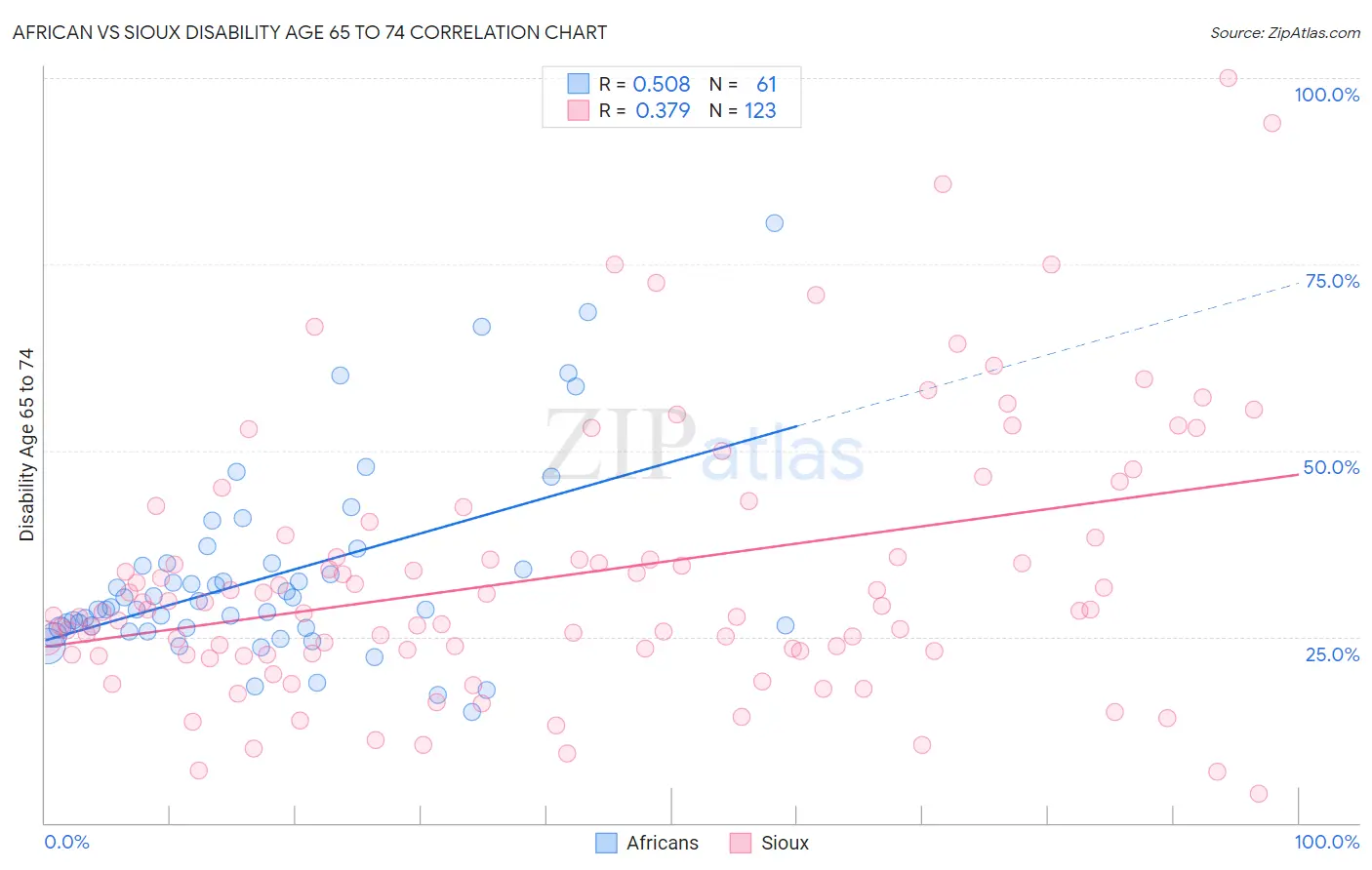African vs Sioux Disability Age 65 to 74
COMPARE
African
Sioux
Disability Age 65 to 74
Disability Age 65 to 74 Comparison
Africans
Sioux
26.2%
DISABILITY AGE 65 TO 74
0.0/ 100
METRIC RATING
289th/ 347
METRIC RANK
27.3%
DISABILITY AGE 65 TO 74
0.0/ 100
METRIC RATING
308th/ 347
METRIC RANK
African vs Sioux Disability Age 65 to 74 Correlation Chart
The statistical analysis conducted on geographies consisting of 468,706,770 people shows a substantial positive correlation between the proportion of Africans and percentage of population with a disability between the ages 65 and 75 in the United States with a correlation coefficient (R) of 0.508 and weighted average of 26.2%. Similarly, the statistical analysis conducted on geographies consisting of 233,824,340 people shows a mild positive correlation between the proportion of Sioux and percentage of population with a disability between the ages 65 and 75 in the United States with a correlation coefficient (R) of 0.379 and weighted average of 27.3%, a difference of 4.3%.

Disability Age 65 to 74 Correlation Summary
| Measurement | African | Sioux |
| Minimum | 14.8% | 4.0% |
| Maximum | 80.6% | 100.0% |
| Range | 65.7% | 96.0% |
| Mean | 33.2% | 33.2% |
| Median | 29.0% | 28.6% |
| Interquartile 25% (IQ1) | 26.2% | 22.8% |
| Interquartile 75% (IQ3) | 34.8% | 38.6% |
| Interquartile Range (IQR) | 8.6% | 15.9% |
| Standard Deviation (Sample) | 13.0% | 17.9% |
| Standard Deviation (Population) | 12.9% | 17.8% |
Demographics Similar to Africans and Sioux by Disability Age 65 to 74
In terms of disability age 65 to 74, the demographic groups most similar to Africans are Immigrants from Cabo Verde (26.3%, a difference of 0.31%), Mexican American Indian (26.2%, a difference of 0.32%), Spanish American Indian (26.4%, a difference of 0.50%), Blackfeet (26.6%, a difference of 1.4%), and Immigrants from Central America (26.6%, a difference of 1.5%). Similarly, the demographic groups most similar to Sioux are Ute (27.3%, a difference of 0.15%), Black/African American (27.3%, a difference of 0.21%), Mexican (27.2%, a difference of 0.61%), Puget Sound Salish (27.2%, a difference of 0.71%), and Tlingit-Haida (27.1%, a difference of 0.83%).
| Demographics | Rating | Rank | Disability Age 65 to 74 |
| Mexican American Indians | 0.0 /100 | #288 | Tragic 26.2% |
| Africans | 0.0 /100 | #289 | Tragic 26.2% |
| Immigrants | Cabo Verde | 0.0 /100 | #290 | Tragic 26.3% |
| Spanish American Indians | 0.0 /100 | #291 | Tragic 26.4% |
| Blackfeet | 0.0 /100 | #292 | Tragic 26.6% |
| Immigrants | Central America | 0.0 /100 | #293 | Tragic 26.6% |
| Dominicans | 0.0 /100 | #294 | Tragic 26.7% |
| Hispanics or Latinos | 0.0 /100 | #295 | Tragic 26.7% |
| Bangladeshis | 0.0 /100 | #296 | Tragic 26.8% |
| Fijians | 0.0 /100 | #297 | Tragic 27.0% |
| Immigrants | Yemen | 0.0 /100 | #298 | Tragic 27.0% |
| Potawatomi | 0.0 /100 | #299 | Tragic 27.0% |
| Immigrants | Dominican Republic | 0.0 /100 | #300 | Tragic 27.0% |
| Immigrants | Mexico | 0.0 /100 | #301 | Tragic 27.1% |
| Central American Indians | 0.0 /100 | #302 | Tragic 27.1% |
| Tlingit-Haida | 0.0 /100 | #303 | Tragic 27.1% |
| Puget Sound Salish | 0.0 /100 | #304 | Tragic 27.2% |
| Mexicans | 0.0 /100 | #305 | Tragic 27.2% |
| Blacks/African Americans | 0.0 /100 | #306 | Tragic 27.3% |
| Ute | 0.0 /100 | #307 | Tragic 27.3% |
| Sioux | 0.0 /100 | #308 | Tragic 27.3% |